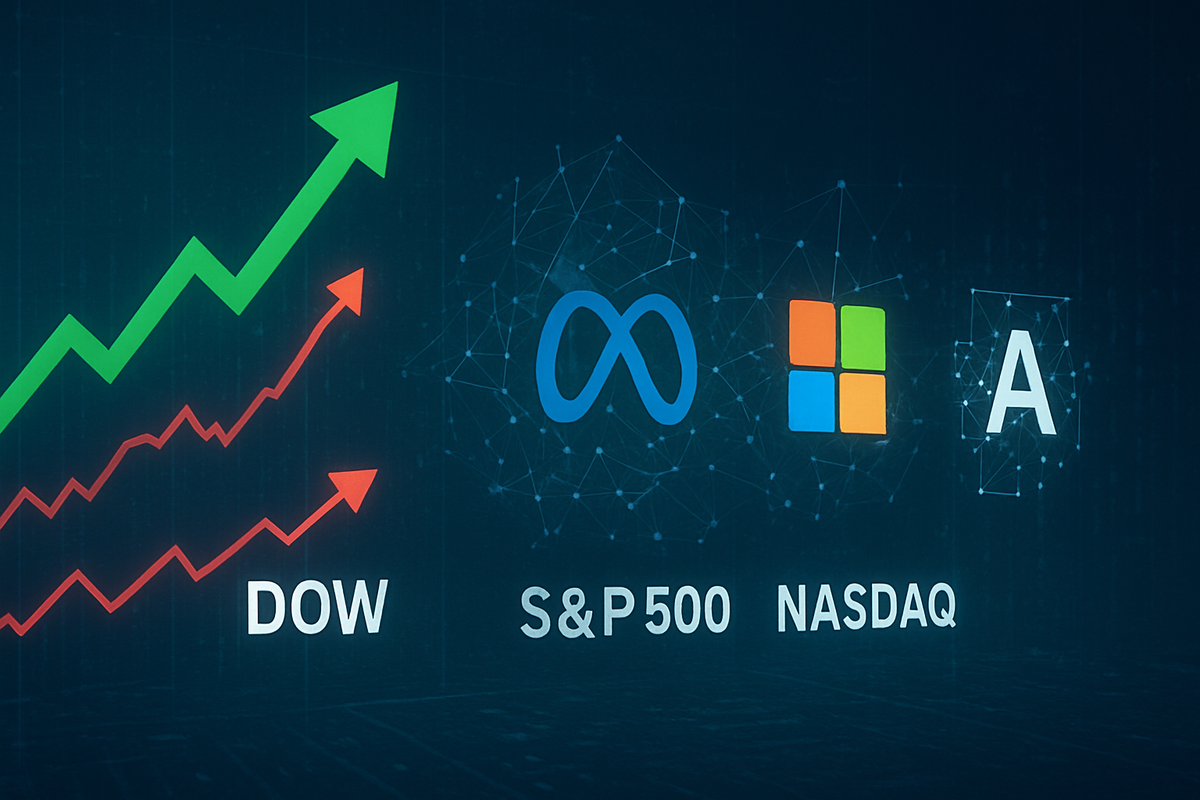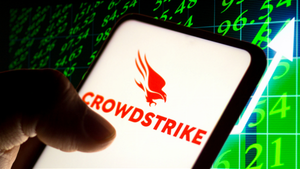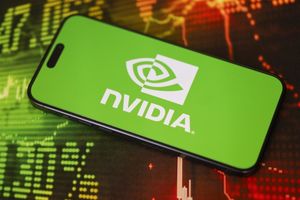
The U.S. stock market opened with a palpable sense of divergence on October 30, 2025, as investors grappled with a mixed bag of quarterly earnings and forward-looking statements from the nation's technology giants. While the venerable Dow Jones Industrial Average (DJIA) managed a modest ascent, both the broader S&P 500 and the tech-heavy Nasdaq Composite found themselves in the red, signaling a cautious mood gripping the markets. This immediate reaction underscores a growing scrutiny of corporate spending, particularly on ambitious artificial intelligence (AI) initiatives, which appears to be separating the market's winners from its losers.
Today's opening bell revealed a market caught between robust current performance and future investment anxieties. The declines in the S&P 500 and Nasdaq, particularly after recent record highs, indicate that strong revenue growth alone is no longer enough to assuage investor concerns about escalating costs associated with AI infrastructure and talent. Conversely, companies demonstrating clear, immediate returns from their AI endeavors are being handsomely rewarded, setting a new benchmark for how the market evaluates tech innovation.
Divergent Fortunes: Tech Earnings Drive Early Market Swings
The morning of October 30, 2025, saw the Dow Jones Industrial Average (DJIA) bucking the downtrend, posting a gain of approximately 0.4% to 0.5%, or 179 to 199 points, to trade around 47,446.88 to 47,550.73. This positive momentum was largely fueled by strong individual performances from constituents like Sherwin-Williams (NYSE: SHW) and Visa (NYSE: V), alongside Eli Lilly (NYSE: LLY), which saw its shares climb on the back of robust Mounjaro and Zepbound drug sales and raised full-year forecasts. However, the optimism was not universal. The S&P 500 slipped between 0.2% and 0.8%, trading around 6,852.15 to 6,860.50, retreating from its recent all-time high. The Nasdaq Composite, heavily weighted with technology stocks, experienced the most significant hit, falling between 0.6% and nearly 1% to open around 23,731.26 to 23,793.08, pulling back from its own record close just yesterday.
The key drivers behind these divergent market movements were the latest quarterly earnings reports from several bellwether technology companies. Investors meticulously dissected these reports, focusing not just on past performance but critically on future spending projections, especially those related to artificial intelligence. Federal Reserve Chair Jerome Powell's recent remarks, suggesting a December interest rate cut is "not a foregone conclusion," also added a layer of caution, tempering expectations for further monetary easing. Meanwhile, a partial trade truce between U.S. President Donald Trump and Chinese leader Xi Jinping provided some underlying stability but did not fully alleviate broader geopolitical uncertainties.
Among the major movers, Meta Platforms (NASDAQ: META) experienced a sharp decline of 9.5% to 12% in early trading. Despite reporting strong third-quarter revenue growth, investors were "perturbed" by the company's forecast for "notably larger" spending in 2026, driven by significant infrastructure costs and increased compensation for AI talent. A substantial one-time tax charge of $15.93 billion, related to the "One Big Beautiful Bill Act," further eroded its earnings per share, amplifying investor concerns about profitability amidst heavy investment.
Microsoft (NASDAQ: MSFT) also saw its shares fall by 2% to 4% at the open. While the software giant surpassed profit and revenue expectations for the latest quarter, its projected increase in capital expenditures for 2026, coupled with a reported $3.1 billion loss to net income from its investment in OpenAI, raised eyebrows. Analysts also noted that the growth of its Azure cloud business, while strong, might have fallen slightly short of the market's elevated expectations, contributing to the cautious reaction.
In stark contrast, Alphabet (NASDAQ: GOOGL), Google's parent company, saw its shares soaring by 4.1% to 8% in early trading. This surge followed a stellar earnings report that saw both profit and revenue for the latest quarter easily surpassing analyst estimates. Alphabet's quarterly revenue exceeded $100 billion for the first time, propelled by robust performance across its Search, Cloud, and YouTube segments, all demonstrating at least 10% sales growth. Crucially, the company raised its 2025 capital expenditure forecast to between $91 billion and $93 billion, signaling aggressive investments in AI and cloud infrastructure, a move that investors explicitly welcomed, with management crediting AI for driving growth in both Search and Cloud.
The AI Investment Divide: Winners and Losers Emerge
Today's market movements vividly illustrate a critical inflection point in the technology sector: the market is now aggressively differentiating between companies that can demonstrate a clear return on their substantial AI investments and those whose spending projections raise concerns about near-term profitability. While the long-term potential of AI is undeniable, investors are increasingly demanding tangible evidence of its monetization and efficiency.
Meta Platforms (NASDAQ: META) found itself in the latter category, experiencing a significant stock drop of 11.3%. Despite reporting robust Q3 2025 results with a 26% year-over-year revenue climb and healthy user growth, investor apprehension was primarily fueled by Meta's projected "notably larger" capital expenditures for 2026, potentially exceeding $100 billion. Unlike some of its peers, Meta lacks a direct cloud division to immediately monetize these infrastructure investments, leaving investors to question the immediate return on investment and its impact on free cash flow and operating margins. The $15.93 billion one-time tax charge from the "One Big Beautiful Bill Act" further compounded these concerns, highlighting the financial burden associated with its ambitious metaverse and AI endeavors.
Microsoft (NASDAQ: MSFT) also saw its shares decline by 2.5%, despite exceeding profit and revenue expectations for its latest quarter. The market's cautious reaction stemmed from the company's accelerating capital expenditures for AI infrastructure in 2026 and the perception that the growth of its dominant Azure cloud business, while strong, might have slightly underperformed some of the market's loftier expectations. The $3.1 billion loss to net income from its investment in OpenAI also weighed on sentiment. However, Microsoft's strategic integration of AI through products like Microsoft 365 Copilot and its deep enterprise penetration position it strongly to convert AI innovation into recurring revenue streams, suggesting that current concerns might be a short-term reaction to heavy investment.
In stark contrast, Alphabet (NASDAQ: GOOGL), Google's parent company, emerged as the day's clear winner, with its shares climbing 5.3% (after an 8% pre-market jump). The market handsomely rewarded Alphabet for its record-breaking Q3 2025 performance, which saw quarterly revenue surpass $100 billion for the first time, easily beating analyst estimates. Crucially, its Google Cloud division soared by 34-35%, driven directly by booming demand for AI-based infrastructure and enterprise data services. The company's robust Google Search and YouTube ad revenues, both up 15%, further solidified investor confidence, as management explicitly credited AI for driving growth across these core segments. Alphabet's increased capital expenditure forecast for 2025 ($91-$93 billion) was viewed not as a burden, but as a justified investment promising clear, immediate returns.
Beyond these titans, the ripple effects are felt across the market. Semiconductor companies like Nvidia (NASDAQ: NVDA) and Broadcom (NASDAQ: AVGO) are clear beneficiaries, as the "insatiable demand" for AI infrastructure from these tech giants directly translates to increased orders for their high-performance GPUs and other hardware. Nvidia, for instance, recently achieved a staggering $5 trillion market capitalization, underscoring the critical role of its technology in the AI boom. Conversely, smaller AI startups and software developers face an increasingly competitive landscape, as Big Tech's aggressive vertical integration and massive spending could either create partnership opportunities or present significant barriers to entry. Data center operators and hardware manufacturers supplying servers and networking equipment also stand to gain from the unprecedented capital outlays.
The AI Gold Rush: A Broader Economic Reordering
The current market's discerning reaction to tech earnings and AI spending on October 30, 2025, is not an isolated event but a potent reflection of deeper, transformative trends reshaping the global economy. This moment marks a critical phase in the AI investment cycle, moving beyond initial hype towards a demand for demonstrable returns and efficient capital allocation, reminiscent yet distinct from past tech booms.
At its core, this trend signifies an accelerated enterprise AI adoption. Generative AI, in particular, has transcended experimental stages to become a strategic imperative for businesses across all sectors. From financial services leveraging AI for fraud detection to healthcare optimizing clinical operations and manufacturing enhancing supply chain efficiency, companies are rapidly integrating AI into their core workflows. This widespread adoption is fueling an unprecedented infrastructure super-cycle, compelling tech giants and other enterprises to pour colossal investments into data centers, specialized chips, and power infrastructure. What were once asset-light tech companies are rapidly becoming asset-heavy, a profound shift with long-term implications for their balance sheets and operational models. The market's current volatility is a testament to this transition, as investors weigh the immediate costs against the promised future productivity gains.
The ripple effects of this AI gold rush are extensive. Semiconductor companies like Nvidia (NASDAQ: NVDA) continue to thrive, experiencing insatiable demand for their GPUs, which are the bedrock of AI computing. Their soaring valuations underscore their critical role in enabling this technological revolution. However, the concentration of AI infrastructure build-outs and deals among a few dominant players – particularly the "Big 5" tech companies (Apple, Microsoft, Amazon, Alphabet, and Meta) – raises legitimate concerns about increased competition and potential market consolidation. Smaller AI startups and software developers face intense pressure to innovate or risk being acquired or sidelined, as the barriers to entry, in terms of capital and talent, continue to escalate. Furthermore, the aggressive pursuit of AI is fundamentally transforming global supply chains, promising enhanced efficiency, transparency, and resilience, but also introducing new challenges related to decarbonization and ethical sourcing.
From a regulatory standpoint, the rapid evolution of AI has created a fragmented and rapidly evolving global landscape. The European Union's AI Act, slated for full implementation through 2025-2026, is emerging as a global benchmark with its risk-based approach, forcing businesses to adopt robust governance models. In the U.S., the focus remains on accelerating AI innovation, building domestic infrastructure, and leading in international AI diplomacy, often intertwined with national security priorities and potential export controls. Critically, antitrust scrutiny is intensifying worldwide, with competition authorities closely monitoring the AI industry for market concentration and potential monopolistic behaviors, particularly concerning the dominance of a few tech giants in essential AI inputs like data and computing power. This regulatory oversight could significantly shape the future competitive dynamics of the AI market.
Comparing this cycle to historical precedents, particularly the dot-com bubble of the late 1990s, offers both parallels and crucial distinctions. Like the dot-com era, there is palpable hype and massive capital investment, with some experts warning of "bubble territory." However, Federal Reserve Chair Jerome Powell and other analysts point to key differences: today's leading AI companies often boast substantial earnings and robust business models, unlike many speculative dot-com startups. Moreover, the AI boom involves tangible physical investments in data centers, power grids, and chip manufacturing, contributing measurably to GDP growth, a stark contrast to the largely speculative nature of the earlier internet boom. While historical infrastructure booms suggest potential overinvestment and poor returns for builders, the transformative potential of AI to fundamentally reshape industries and boost global GDP is widely acknowledged, making the current period a unique blend of opportunity and risk.
The Road Ahead: Navigating the AI Supercycle's Complexities
As the market grapples with the immediate aftermath of tech earnings and the implications of colossal AI investments on October 30, 2025, the path forward for the stock market and major tech companies appears to be one of both immense opportunity and significant strategic complexity. The "AI supercycle" is undeniably underway, but its trajectory is far from smooth, demanding careful navigation and adaptable strategies from corporations and investors alike.
In the short-term (late 2025 - 2026), the market is poised for heightened discernment. Investors will increasingly favor companies that can not only articulate their AI vision but also demonstrate clear monetization strategies and tangible profitability from their substantial AI capital expenditures. The recent mixed earnings, where robust revenue growth was overshadowed by concerns over escalating CapEx, underscore this shift. Companies like Meta, facing investor "perturbation" over massive spending without a direct cloud monetization path, exemplify the scrutiny. The debate around an "AI bubble" will likely intensify, especially as credit markets show warning signs amidst trillion-dollar spending sprees. However, the foundational build-out of AI infrastructure—chips, software, and cloud services—will continue, with global AI investment projected to surge to $1.48 trillion in 2025 and potentially exceeding $2 trillion by 2026.
Looking long-term (beyond 2026), the outlook remains largely optimistic for those who successfully harness AI. This technology is widely seen as a foundational driver of productivity gains, capable of creating entirely new industries and revolutionizing existing ones. Companies that effectively integrate AI into their core operations and develop innovative AI-powered products and services are positioned for durable, sustained growth. Analysts project AI-related software, infrastructure, and services to generate over $15 trillion in global economic output by 2030, suggesting a transformative era akin to the internet revolution. The burgeoning demand for data centers to run AI workloads, projected to increase by 19-22% annually by 2030, highlights the physical manifestation of this digital revolution.
To thrive in this evolving landscape, strategic pivots are paramount. Companies must move beyond mere investment to demonstrable ROI, showcasing how AI directly contributes to revenue, improves margins, or significantly enhances efficiency. This means a shift from simply building infrastructure to effectively integrating AI into profitable applications. Furthermore, diversification of AI investment is crucial; while "shovel sellers" in semiconductors and cloud infrastructure are current beneficiaries, opportunities to leverage AI in non-tech sectors like healthcare, logistics, and finance are vast and largely untapped. Effective talent management will also be critical, as the volatile "hire and fire" cycle for AI specialists in 2025 underscores the need for sustainable strategies to attract, retain, and reskill professionals. Finally, proactively addressing regulatory and ethical concerns related to AI's influence on misinformation, privacy, and market concentration will be essential for maintaining public trust and avoiding punitive measures.
Market opportunities abound in AI infrastructure, AI software and services, and the application of AI in traditional industries. The surging demand for advanced semiconductors, cloud computing, and data center capacity presents clear growth avenues. Moreover, the rise of AI-driven threats like deepfakes and disinformation creates new cybersecurity and cognitive security opportunities. However, significant challenges persist: the looming threat of an "AI bubble," the complex puzzle of proving profitability from massive AI outlays, intense competition, talent shortages, and increasing regulatory scrutiny. Potential scenarios range from an "AI Supercycle" with selective growth for companies that master AI monetization, to a market correction and consolidation if profitability remains elusive, or a bifurcation of the tech industry where only the most adept AI integrators flourish. Ultimately, the long-term outcome is expected to be a world where AI significantly enhances human capabilities and drives global productivity, but the journey there will undoubtedly test the resilience and foresight of market participants.
The AI Investment Reckoning: A Market in Transition
The close of trading on October 30, 2025, solidifies a critical juncture for the financial markets, particularly within the technology sector. The day's mixed performance, characterized by the Dow's modest rise against declines in the S&P 500 and Nasdaq, underscored a market in transition. While the transformative power of Artificial Intelligence (AI) remains the undisputed long-term growth narrative, investors are clearly moving beyond speculative enthusiasm to demand concrete evidence of return on investment from the massive capital outlays dedicated to AI.
Key takeaways from today's market action highlight this shift: AI remains the dominant investment theme, driving significant capital flow and impacting all facets of investment management, from cloud computing to digital advertising. Tech earnings, while generally robust, are now under intense scrutiny, with companies facing investor backlash if their aggressive AI spending plans don't come with a clear path to immediate monetization. The cautionary optimism that defines the current market is further shaped by persistent macroeconomic headwinds, including inflation concerns, the Federal Reserve's stance on interest rates, and the lingering impacts of geopolitical developments and tariffs. Critically, the market is distinguishing between the pervasive "Generative AI hype" and the pragmatic, value-driven "traditional AI solutions" that offer clearer, more immediate ROI.
Assessing the market moving forward, the AI narrative will continue to dominate, but with a more discerning eye. The "AI arms race" will intensify, leading to sustained opportunities for providers of AI infrastructure—semiconductors, cloud services, and data centers. However, this bullish outlook is tempered by anticipated volatility in AI stocks, driven by uncertainties regarding the profitability of AI spending, the immense energy demands of AI, and the evolving regulatory landscape. The broader economic environment, encompassing inflation trends, central bank policies, and trade dynamics, will continue to be pivotal in shaping overall market sentiment. A resilient labor market and sustained consumer spending are expected to provide a floor for continued, albeit moderated, economic growth.
In final thoughts on significance and lasting impact, October 30, 2025, will be remembered as a period where the AI revolution solidified its grip on the economy, pushing companies to demonstrate not just innovation, but also financial discipline. The deep integration of AI into investment management itself, offering real-time insights and automated trading, is poised to redefine the financial industry. This era's lasting legacy will be determined by how effectively corporations translate their AI investments into tangible productivity gains and sustainable competitive advantages, leading to a more mature and resilient AI ecosystem. Geopolitical factors, particularly trade policies, will also play a crucial long-term role in shaping global supply chains and corporate profitability.
What investors should watch for in the coming months includes, first and foremost, AI monetization and ROI. Scrutinize earnings reports for clear strategies on how AI is generating revenue or improving margins. Continue to monitor tech earnings reports, especially from mega-cap companies, for insights into growth drivers and forward-looking guidance on AI capital allocation. Keep a close eye on inflation data and the Federal Reserve's interest rate trajectory, as these will dictate the broader economic environment. Economic indicators, such as manufacturing orders, consumer sentiment, and the unemployment rate, will provide clues about overall economic health. Investors should also remain vigilant regarding geopolitical developments and tariffs, which can introduce significant market volatility. Finally, considering sector diversification beyond just tech, potentially into cyclical, value-style investments, and international markets, along with a focus on cybersecurity and evolving AI regulation, will be crucial for navigating the complexities of this transformative period.
This content is intended for informational purposes only and is not financial advice





